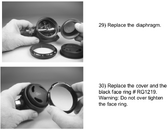reefvagabond
Contributor
So I dove a site that required me to crawl out of the surf during which I got some sand and rocks in my 2nd stage. I couldn't shake them out so I unscrewed the top, removed the diaphragm and dumped the sand/rocks out. I have put the diaphragm back and followed the instructions provided in the regulator's manual. It seems okay, however I would like some feedback because I have never done this before.

That's the instructions for my Dive Rite 2nd stage. Is it as simple as just laying the diaphragm on top and screwing the rest of it on? Am I supposed to do anything more, like does the diaphram have to be air tight when I put it on and if so how would I do that? Any recommended procedures for testing it after I'm done?

That's the instructions for my Dive Rite 2nd stage. Is it as simple as just laying the diaphragm on top and screwing the rest of it on? Am I supposed to do anything more, like does the diaphram have to be air tight when I put it on and if so how would I do that? Any recommended procedures for testing it after I'm done?



